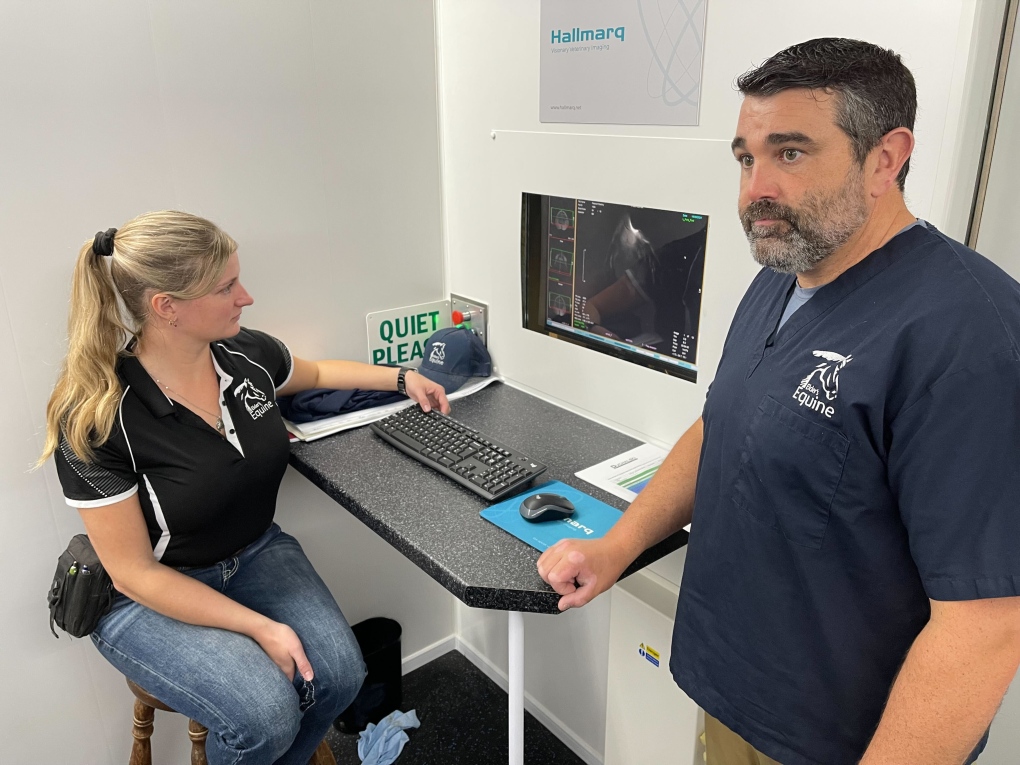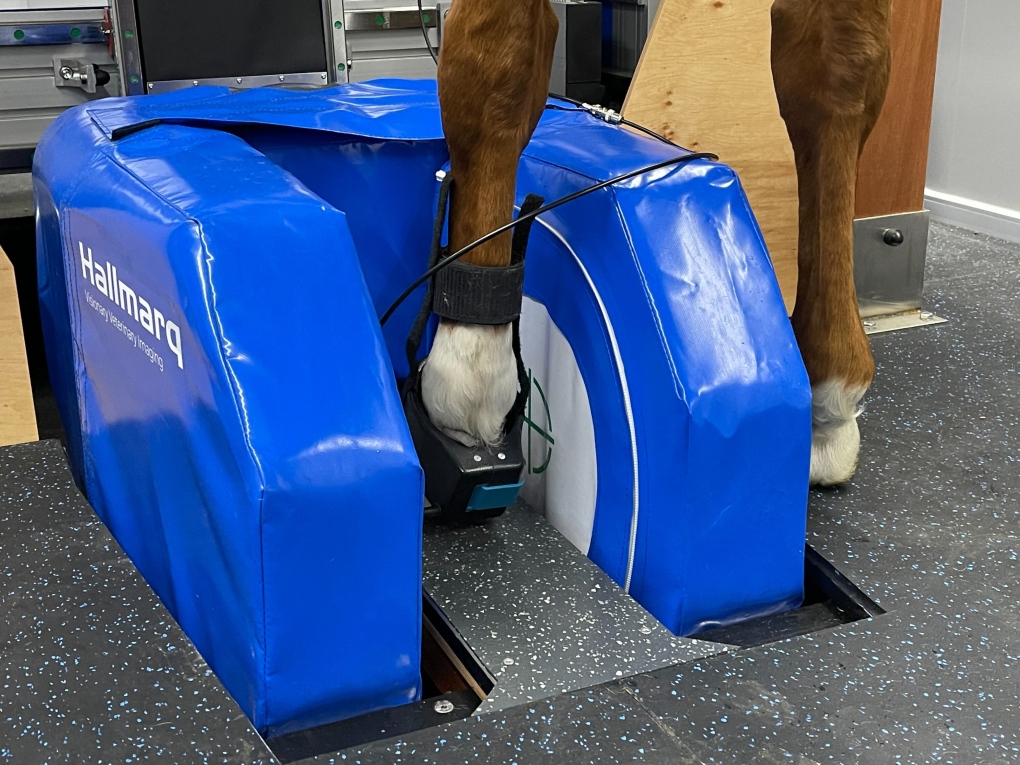Manitoba horses now have fast, local access to MRI and CT scans
A Manitoba veterinary clinic has two new ways of figuring out what’s causing a horse to be lame.
Dr. Chris Bell, owner of Elder’s Equine west of Winnipeg, installed an MRI and a CT scanner a few weeks ago. Both are designed to image a horse’s lower leg, the most common spot for injury.
- The information you need to know, sent directly to you: Download the CTV News App
- Sign up now for daily CTV News Winnipeg newsletters
“The whole, ‘Horse broke its leg, I have to put it down,’ is really a very antiquated idea around what we can do in equine medicine,” he said.
“Now, we have horses that we repair fractures on, and they go on to live very healthy and fruitful lives.”
Bell said the demand is growing for MRI and CT scanning in equine medicine because it takes out the guesswork. It also helps the owner by saving time and money on ineffective treatments.
"We are able to offer, rapid access to very high quality, advanced imaging," he said.
The wait to get a horse in for an MRI is a few days to a week, Bell said. Veterinary technologist Brynn Dosko and veterinarian Dr. Chris Bell wait for images inside the new equine MRI on Sept. 19, 2024 (Michelle Gerwing/CTV News Winnipeg)
Veterinary technologist Brynn Dosko and veterinarian Dr. Chris Bell wait for images inside the new equine MRI on Sept. 19, 2024 (Michelle Gerwing/CTV News Winnipeg)
Getting answers quickly is a relief for owners said Brynn Dosko, a registered veterinary technologist. She is trained to operate both the MRI and the CT scanner.
“We've had a few clients that came with unknown lameness issues with their horses, and we've put them in and done a scan, and it's like, ‘Wow, there's an answer,’” she said.
It’s also comforting to staff caring for the horses. Veterinary assistant Rachael Van Wyk said the patients so far have been predominantly horses working on farms or performing in rodeos or shows.
“Our goal is to get these horses in here and figure out what’s wrong with them so that we can help them the best we can so they can get back to being comfortable and being happy and healthy," said Van Wyk.
Bell said a horse is put under partial sedation, so it can walk in, get scanned, and walk back out.
A scan, depending on the case, takes about 45 minutes to an hour. An MRI costs about $3,000 and a CT scan is about $1,500.
The machines are housed in climate-controlled containers that can operate even on Manitoba’s coldest winter days.
A mare named Destiny was booked in for an MRI on Wednesday. She has a front left foot injury, but Bell said her X-rays came back normal.
 A mare's front left foot is carefully placed inside an equine MRI so it can be imaged and properly diagnosed on Sept. 19, 2024. (Michelle Gerwing/CTV News Winnipeg)
A mare's front left foot is carefully placed inside an equine MRI so it can be imaged and properly diagnosed on Sept. 19, 2024. (Michelle Gerwing/CTV News Winnipeg)
“After we've identified that it is for sure the foot that is the problem, we'll get them into the MRI and then we are going to have a look at their tendons and ligaments," he said.
Once images started popping up Bell and his technologists could tell right away there was fluid around one of her tendons. Bell said there's likely a tear, but he will know for sure what the treatment is once the radiology report comes back in 24 hours.
Theoretically, Bell said the CT and MRI machines could be used on more than just horses.
“They're a little bit different in the way they function because they are looking mainly at the limb of a standing horse,” said Bell. “But theoretically you could do a human leg in there.”
Bell plans on sticking to scanning ponies, mares, and stallions because that’s what’s in his scope of practice.
He said the next closest equine MRIs are in Saskatoon and Calgary.
CTVNews.ca Top Stories

Thousands of structures destroyed in L.A. County's most destructive fire
A series of wildfires tore through densely populated parts of the Los Angeles, Calif. area. Five people have been reported dead. U.S. Gov. Gavin Newsom said thousands of resources have been deployed to contain the fires.
Is the Hollywood sign on fire?
As fires scorch Los Angeles, fake images and videos of a burning Hollywood sign have circulated on social media.
U.S. Supreme Court rejects Trump's bid to delay sentencing in his New York hush money case
A sharply divided U.S. Supreme Court on Thursday rejected president-elect Donald Trump's final bid to put his New York hush-money case on hold, clearing the way for him to be sentenced for felony crimes days before he returns to the presidency.
Ex-Trump adviser says Canada in 'difficult position' amid tariff threat, Trudeau resignation
In the face of a potential tariff war, U.S. president-elect Donald Trump's former national security adviser John Bolton says 'Canada is in a difficult position' in part due to Prime Minister Justin Trudeau's resignation and a looming general election.
PM Trudeau says he thinks Trump is using talk of Canada becoming 51st state to distract from tariff impact
Prime Minister Justin Trudeau says he thinks U.S. president-elect Donald Trump is drumming up drama on Canadian statehood to detract from tariff talks.
Canadian travellers now require an ETA to enter U.K. Here's what to know
Starting Jan. 8, Canadians visiting the U.K. for short trips will need to secure an Electronic Travel Authorization (ETA) before boarding their flight, according to regulations set out by the U.K. government.
'True when I said it, true today': former Canadian PM Harper pushes back against Trump on social media
Former prime minister Stephen Harper doesn’t find U.S. president-elect Donald Trump’s jibes about Canada becoming the 51st U.S. state very amusing.
Poilievre says the next Canadian election will be about the carbon price
Pierre Poilievre returned to Ottawa on Thursday after the holidays with a familiar demand for Justin Trudeau: call a carbon-tax election.
More than 150 students sick at University of Guelph, says public health
More than 150 cases of gastroenteritis have been reported at the University of Guelph.
































